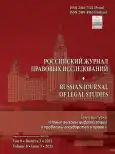Application of the Principles of International Humanitarian Law (Principles of Distinction, Proportionality, and Precaution) to Armed Conflicts in Cyberspace
- 作者: Garkusha-Bozhko S.Y.1
-
隶属关系:
- St.-Petersburg State Budgetary Institution Olympic Reserve Sports School “School of Higher Sportsmanship in Water Sports named after Yu.S. Tyukalov”
- 期: 卷 8, 编号 3 (2021)
- 页面: 73-90
- 栏目: International law
- ##submission.dateSubmitted##: 05.06.2021
- ##submission.dateAccepted##: 18.08.2021
- ##submission.datePublished##: 07.10.2021
- URL: https://journals.eco-vector.com/2410-7522/article/view/71332
- DOI: https://doi.org/10.17816/RJLS71332
- ID: 71332
如何引用文章
详细
Information technology development in the modern world affects all spheres of human activity on a global scale, including the sphere of military activities of States. The current level of military information technologies development allows us to talk about a possible new theater of military operations, namely, cyberspace. In this regard, it is necessary to analyze the problem of applying the principles of international humanitarian law (IHL), in particular the principles of distinction, proportionality, and precaution, to armed conflicts in cyberspace, which is the subject of this article. However, the application of the basic principles of this branch of international law in cyberspace raises a number of problematic issues that require in-depth research, specifically the application of principles of IHL to cyberspace. The research of such issues is the purpose of this article.
Based on the results of this research, the author came to the following conclusions: 1) the application of the principle of distinction in cyberspace is unlikely to ensure the protection of dual-use objects. More important for the protection of such objects in cyberspace is the principle of proportionality; 2) whether IT companies that supply technical equipment and software for military needs qualify as a military facility depends on how much such a company is involved in procurement activities; 3) objects in cyberspace that support the military potential of a state are not military objects; 4) social networks are not military targets; 5) in the context of an armed conflict in cyberspace, the parties to such conflicts have a duty to carefully check the cyber means used in a cyber-attack for compliance with the prohibition of attacks of an indiscriminate nature; 6) the issue of taking precautionary measures against cyber-attacks and their consequences is at the stage of developing state practices. However, it should be assumed that this fact does not negate the obligation of States to take such measures in the event of cyber-attacks—this obligation lies with the States due to the application of the principles of IHL to cyberspace.
全文:
作者简介
Sergei Garkusha-Bozhko
St.-Petersburg State Budgetary Institution Olympic Reserve Sports School “School of Higher Sportsmanship in Water Sports named after Yu.S. Tyukalov”
编辑信件的主要联系方式.
Email: garkusha-bozhko.sergej@yandex.ru
ORCID iD: 0000-0003-1253-3157
legal counsel
俄罗斯联邦, Saint Petersburg参考
- Melzer N. International humanitarian law: A comprehensive introduction. Moscow, ICRC, 2017. 420 p. (In Russ.).
- Tallinn Manual on the international law applicable to cyber warfare. Gen. ed. M. N. Schmitt. Cambridge University Press, 2013. XX. 282 p.
- Pechegin DA. Combination of adversarial and investigative aspects in criminal procedure: international criminal court practice. Zakonodatelstvo. 2015;(2):69–77. (In Russ.).
- Tallinn Manual 2.0 on the international law applicable to cyber operations. Gen. ed. MN Schmitt. Cambridge University Press, 2017. XLII. 598 p.
- Danelʹian AA. Mezhdunarodno-pravovoe regulirovanie kiberprostranstva. Education and law. 2020;(1):261–269. (In Russ.).
- Lin H. Cyber conflict and international humanitarian law. International review of the Red Cross. 2012;94(886):515–531.
- Talimonchik VP. International legal means of combating information weapons. Russian yearbook of international law. 2015;(Special Issue):135–143. (In Russ.).
- Hathaway OA, Crootof R, Levitz Ph, Nix H, et al. The law of cyber-attack. California law review. 2012;100(4):817–885.
- Henckaerts J-M, Doswald-Beck L. Customary international humanitarian law. Volume I: Rules, Moscow, ICRC, 2006. LXVII. 819 p. (In Russ.).
- Jensen ET. Unexpected Consequences from knock-on effects: A different standard for computer network operations? American university international law review. 2003;18(5):1145–1188.
- Kelsey JTG. Hacking into international humanitarian law: The principles of distinction and neutrality in the age of cyber warfare. Michigan law review. 2008;106(7):1427–1451.
- Huang Z, Ying Y. The application of the principle of distinction in the cyber context: A Chinese perspective. International review of the Red Cross. 2020;102(913):335–365.
- Droege C. Get off my cloud: cyber warfare, international humanitarian law, and the protection of civilians. International review of the Red Cross. 2012;94(886):533–578. (In Russ.).
- Schaap AJ. Cyber warfare operations: development and use under international law. Air force law review. 2009;(64):121–173.
- Geiß R, Lahmann H. Cyber warfare: Applying the principle of distinction in an interconnected space. Israel law review. 2012;45(3):381–399.
- Jensen ET. Cyber warfare and precautions against the effects of attacks. Texas law review. 2010;(88): 1533–1569.
- Sassòli M, Bouvier A. How does law protect in war? Cases, documents and teaching materials on contemporary practice in international humanitarian law. Vol. IV. Moscow, ICRC, 2009. 908 p. (In Russ.).
- Schmitt MN. Cyber operations and the Jus in Bello: Key Issues. Naval war college international law studies. 2011;(87):89–110.
- Schmitt MN. Bellum Americanum: The U.S. view of twenty-first century war and its possible implications for the law of armed conflict. Michigan Journal of international law. 1998;19(4):1051–1090.
- Doswald-Beck L. Some thoughts on computer network attack and the international law of armed conflict. Computer network attack and international law. Ed. by M. N. Schmitt and B. T. O’Donnell. Newport, Rhoad Island: US Naval War College Press, 2002. P. 163–185.
- Schmitt MN. Computer network attack: The Normative software. Yearbook of international humanitarian law. 2001:53–85.
- Quéguiner J-F. Precautions under the law governing the conduct of hostilities. International review of the Red Cross. 2006;88(864):793–821.
补充文件






